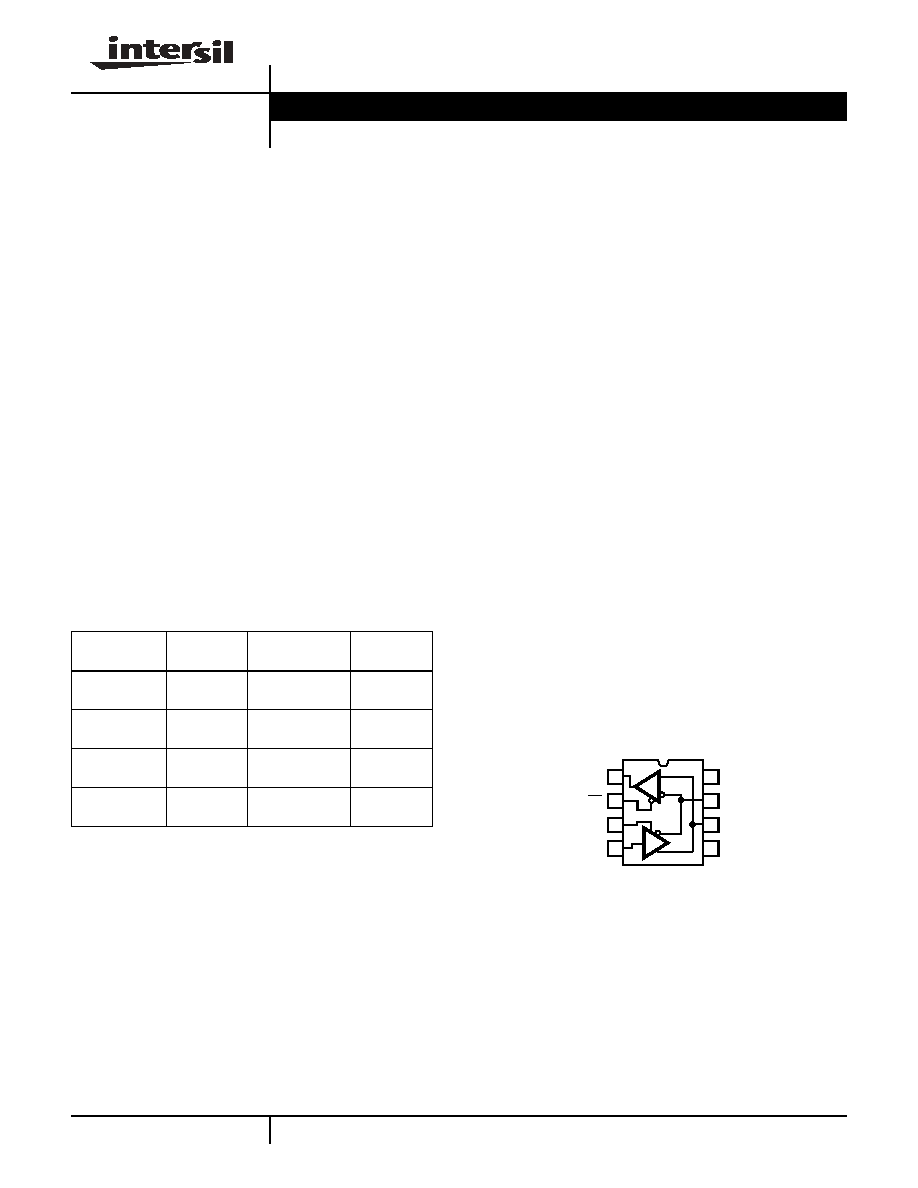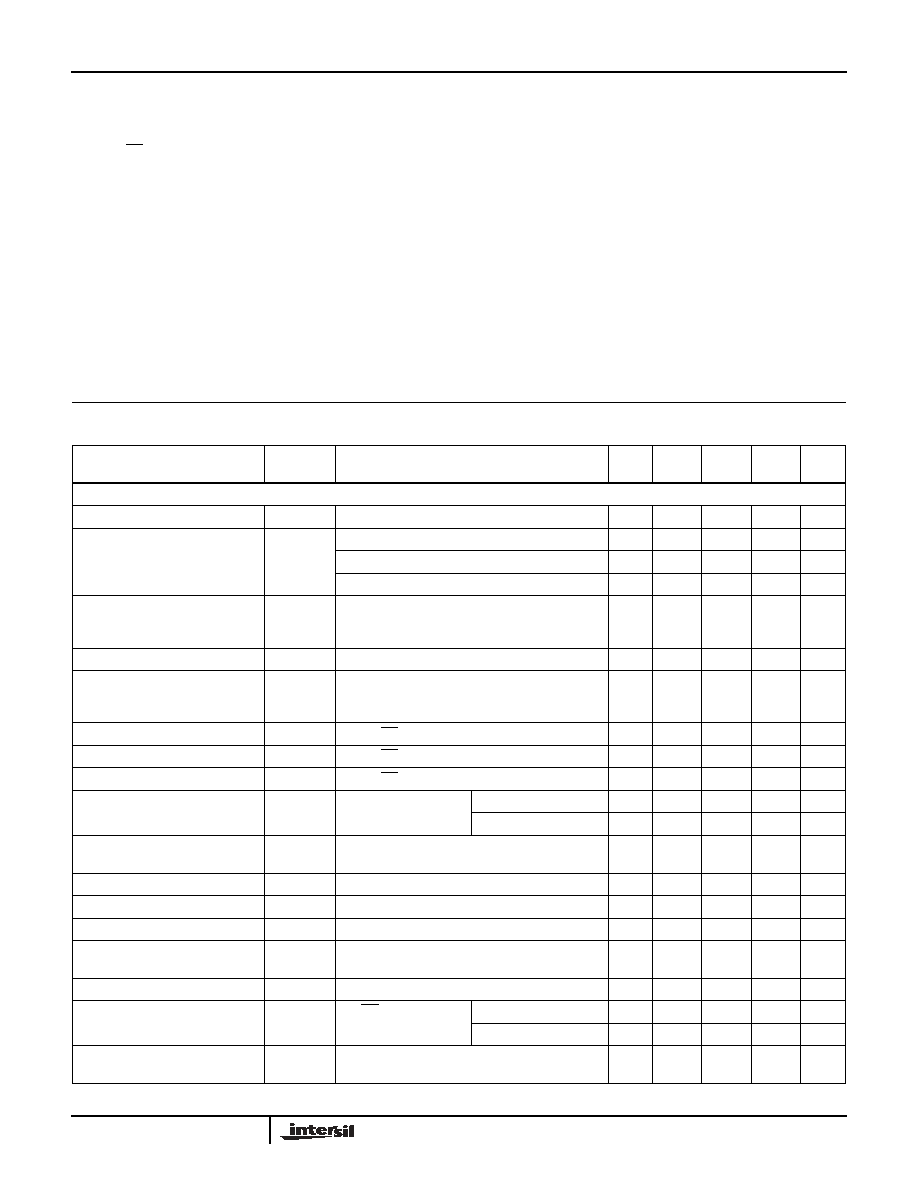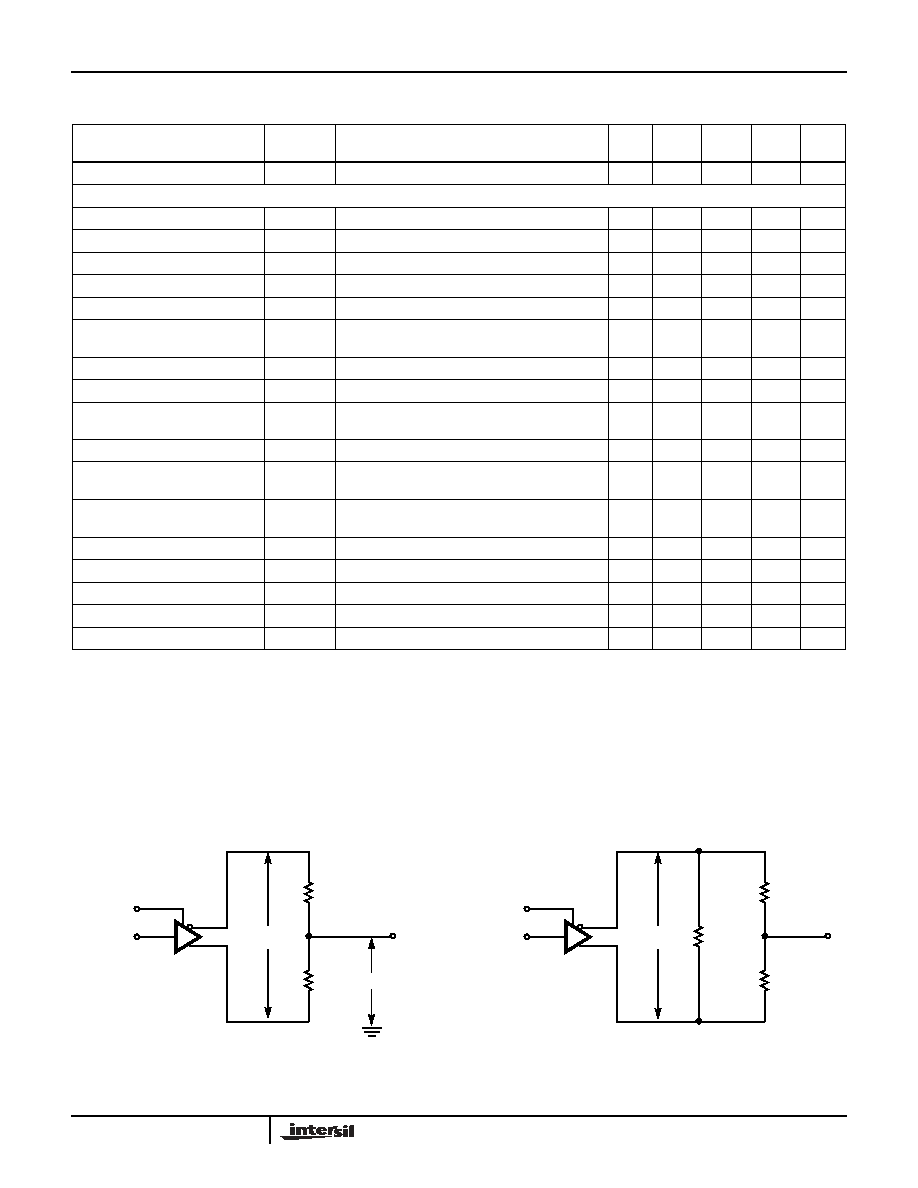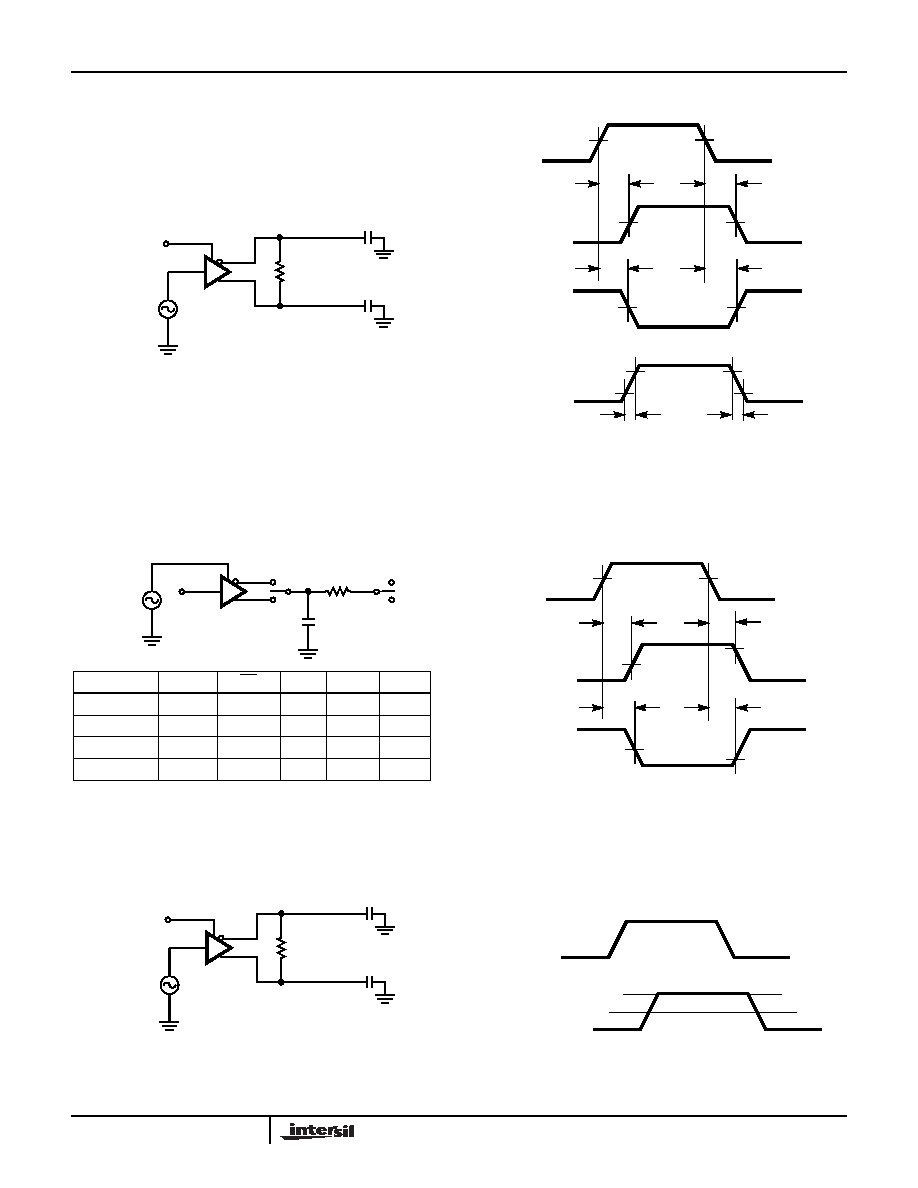 | –≠–ª–µ–∫—Ç—Ä–æ–Ω–Ω—ã–π –∫–æ–º–ø–æ–Ω–µ–Ω—Ç: ISL81485 | –°–∫–∞—á–∞—Ç—å:  PDF PDF  ZIP ZIP |

1
Æ
FN6061
ISL81485
5V, 30Mbps, RS-485/RS-422 Transceiver
The Intersil ISL81485 is a BiCMOS, 5V powered, single
transceiver that meets both the RS-485 and RS-422
standards for balanced communication, and features a
larger output voltage and higher data rate to benefit high
speed applications.
Unlike competitive devices, this Intersil transceiver is
specified for 10% tolerance supplies (4.5V to 5.5V), and it
delivers a much larger worst case differential output voltage
(2.0V compared to the typical 1.5V) over the full supply
range. The increased output voltage translates into longer
reach, or better data integrity, at the 30Mbps data rate.
This device presents a "1 unit load" to the RS-485 bus,
which allows up to 32 transceivers on the network.
Receiver (Rx) inputs feature a "fail-safe if open" design,
which ensures a logic high Rx output if Rx inputs are
floating.
Driver (Tx) outputs are short circuit protected, even for
voltages exceeding the power supply voltage. Additionally,
on-chip thermal shutdown circuitry disables the Tx outputs to
prevent damage if power dissipation becomes excessive.
Features
∑ Specified for 10% Tolerance Supplies
∑ High Data Rates. . . . . . . . . . . . . . . . . . . . . up to 30Mbps
∑ Large Differential Output Voltage. . . . 2.0V(min.) into 54
∑ Drop-In Replacement for the ADM1485
∑ One Unit Load Allows up to 32 Devices on the Bus
∑ Low Quiescent Current . . . . . . . . . . . . . . . . . . . . . 800
µ
A
∑ -7V to +12V Common Mode Input Voltage Range
∑ Three State Rx and Tx Outputs
∑ 15ns (Max) Propagation Delays, 5ns (Max) Skew
∑ Operates from a Single +5V Supply (10% Tolerance)
∑ Current Limiting and Thermal Shutdown for driver
Overload Protection
Applications
∑ SCSI "Fast 20" Drivers and Receivers
∑ Factory Automation
∑ Field Bus Networks
∑ Security Networks
∑ Building Environmental Control Systems
∑ Industrial/Process Control Networks
Ordering Information
PART NO.
(BRAND)
TEMP.
RANGE (
o
C)
PACKAGE
PKG. DWG. #
ISL81485IB
(81485IB)
-40 to 85
8 Ld SOIC
M8.15
ISL81485IB-T
(81485IB)
-40 to 85
8 Ld SOIC
(Tape and Reel)
M8.15
ISL81485IU
(1485)
-40 to 85
8 Ld MSOP
M8.118
ISL81485IU-T
(1485)
-40 to 85
8 Ld MSOP
(Tape and Reel)
M8.118
Pinout
ISL81485 (SOIC, MSOP)
TOP VIEW
RO
RE
DE
DI
1
2
3
4
8
7
6
5
V
CC
B / Z
A / Y
GND
D
R
Data Sheet
December 2003
CAUTION: These devices are sensitive to electrostatic discharge; follow proper IC Handling Procedures.
1-888-INTERSIL or 321-724-7143
|
Intersil (and design) is a registered trademark of Intersil Americas Inc.
Copyright © Intersil Americas Inc. 2003. All Rights Reserved
All other trademarks mentioned are the property of their respective owners.

2
Truth Table
TRANSMITTING
INPUTS
OUTPUTS
RE
DE
DI
B / Z
A / Y
X
1
1
0
1
X
1
0
1
0
X
0
X
High-Z
High-Z
Truth Table
RECEIVING
INPUTS
OUTPUT
RE
DE
A-B
RO
0
0
+0.2V
1
0
0
-0.2V
0
0
0
Inputs Open
1
1
X
X
High-Z
Pin Descriptions
PIN
FUNCTION
RO
Receiver output: If A > B by at least 0.2V, RO is high; If A < B by 0.2V or more, RO is low; RO = High if A and B are unconnected (floating).
RE
Receiver output enable. RO is enabled when RE is low; RO is high impedance when RE is high.
DE
Driver output enable. The driver outputs, Y and Z, are enabled by bringing DE high. They are high impedance when DE is low.
DI
Driver input. A low on DI forces output Y low and output Z high. Similarly, a high on DI forces output Y high and output Z low.
GND
Ground connection.
A/Y
RS-485/422 level, noninverting receiver input and noninverting driver output. Pin is an input (A) if DE = 0; pin is an output (Y) if DE = 1.
B/Z
RS-485/422 level, inverting receiver input and inverting driver output. Pin is an input (B) if DE = 0; pin is an output (Z) if DE = 1.
V
CC
System power supply input (4.5V to 5.5V).
Typical Operating Circuit
ISL81485
0.1
µ
F
+
D
R
7
6
8
1
2
3
4
5
V
CC
GND
RO
RE
DE
DI
A / Y
B / Z
+5v
0.1
µ
F
+
D
R
6
7
8
1
2
3
4
5
V
CC
GND
RO
RE
DE
DI
A / Y
B / Z
+5v
R
T
R
T
ISL81485

3
Absolute Maximum Ratings
Thermal Information
V
CC
to Ground. . . . . . . . . . . . . . . . . . . . . . . . . . . . . . . . . . . . . . . 7V
Input Voltages
DI, DE, RE . . . . . . . . . . . . . . . . . . . . . . . . . . . . . . . . . -0.5V to 7V
Input / Output Voltages
A/Y, B/Z . . . . . . . . . . . . . . . . . . . . . . . . . . . . . . . . . -8V to +12.5V
RO . . . . . . . . . . . . . . . . . . . . . . . . . . . . . . . . -0.5V to (V
CC
+0.5V)
Short Circuit Duration
Y, Z. . . . . . . . . . . . . . . . . . . . . . . . . . . . . . . . . . . . . . . Continuous
Operating Conditions
Temperature Range
ISL81485IX. . . . . . . . . . . . . . . . . . . . . . . . . . . . . . . -40
o
C to 85
o
C
Thermal Resistance (Typical, Note 1)
JA
(
o
C/W)
8 Ld SOIC Package . . . . . . . . . . . . . . . . . . . . . . . . .
105
8 Ld MSOP Package . . . . . . . . . . . . . . . . . . . . . . . .
140
Maximum Junction Temperature (Plastic Package) . . . . . . . 150
o
C
Maximum Storage Temperature Range . . . . . . . . . -65
o
C to 150
o
C
Maximum Lead Temperature (Soldering 10s) . . . . . . . . . . . . 300
o
C
(Lead Tips Only)
CAUTION: Stresses above those listed in "Absolute Maximum Ratings" may cause permanent damage to the device. This is a stress only rating and operation of the
device at these or any other conditions above those indicated in the operational sections of this specification is not implied.
NOTE:
1.
JA
is measured with the component mounted on a high effective thermal conductivity test board in free air. See Tech Brief TB379 for details.
Electrical Specifications
Test Conditions: V
CC
= 4.5V to 5.5V; Unless Otherwise Specified. Typicals are at V
CC
= 5V, T
A
= 25
o
C,
Note 2
PARAMETER
SYMBOL
TEST CONDITIONS
TEMP
(
o
C)
MIN
TYP
MAX
UNITS
DC CHARACTERISTICS
Driver Differential V
OUT
(no load)
V
OD1
Full
-
-
V
CC
V
Driver Differential V
OUT
(with load)
V
OD2
R = 50
(RS-422) (Figure 1A)
Full
2.5
3
-
V
R = 27
(RS-485) (Figure 1A)
Full
2
2.5
5
V
R
D
= 60
, -7V
V
CM
12V (Figure 1B)
Full
1.5
-
-
V
Change in Magnitude of Driver
Differential V
OUT
for
Complementary Output States
V
OD
R = 27
or 50
(Figure 1A)
Full
-
0.01
0.2
V
Driver Common-Mode V
OUT
V
OC
R = 27
or 50
(Figure 1A)
Full
-
-
3
V
Change in Magnitude of Driver
Common-Mode V
OUT
for
Complementary Output States
V
OC
R = 27
or 50
(Figure 1A)
Full
-
0.01
0.2
V
Logic Input High Voltage
V
IH
DE, DI, RE
Full
2
-
-
V
Logic Input Low Voltage
V
IL
DE, DI, RE
Full
-
-
0.8
V
Logic Input Current
I
IN1
DE, DI, RE
Full
-1
-
1
µ
A
Input Current (A/Y, B/Z) (Note 5)
I
IN2
DE = 0V, V
CC
= 0V or
4.5 to 5.5V
V
IN
= 12V
Full
-
-
1
mA
V
IN
= -7V
Full
-0.8
-
-
mA
Receiver Differential Threshold
Voltage
V
TH
-7V
V
CM
12V
Full
-0.2
-
0.2
V
Receiver Input Hysteresis
V
TH
V
CM
= 0V
25
-
40
-
mV
Receiver Output High Voltage
V
OH
I
O
= -4mA, V
ID
= 200mV
Full
4
-
-
V
Receiver Output Low Voltage
V
OL
I
O
= -4mA, V
ID
= 200mV
Full
-
-
0.4
V
Three-State (high impedance)
Receiver Output Current
I
OZR
0.4V
V
O
2.4V
Full
-
-
±
1
µ
A
Receiver Input Resistance
R
IN
-7V
V
CM
12V
Full
12
-
-
k
No-Load Supply Current, Note 3
I
CC
DI, RE = 0V or V
CC
DE = V
CC
Full
-
1
2.2
mA
DE = 0V
Full
-
0.8
1
mA
Driver Short-Circuit Current,
V
O
= High or Low
I
OSD1
DE = V
CC
, -7V
V
Y
or V
Z
12V (Note 4)
Full
60
-
250
mA
ISL81485

4
Receiver Short-Circuit Current
I
OSR
0V
V
O
V
CC
Full
7
-
85
mA
SWITCHING CHARACTERISTICS
Driver Input to Output Prop Delay
t
PLH
, t
PHL
R
DIFF
= 54
, C
L
= 100pF (Figure 2)
Full
2
9
15
ns
Driver Prop Delay Skew
t
SKEW
R
DIFF
= 54
, C
L
= 100pF (Figure 2)
Full
-
1
5
ns
Driver Differential Rise or Fall Time
t
R
, t
F
R
DIFF
= 54
, C
L
= 100pF (Figure 2)
Full
-
5
15
ns
Driver Enable to Output High
t
ZH
C
L
= 50pF, SW = GND (Figure 3)
Full
-
9
25
ns
Driver Enable to Output Low
t
ZL
C
L
= 50pF, SW = V
CC
(Figure 3)
Full
-
9
25
ns
Matched Enable Switching
|t
AZH
- t
BZL
| or |t
BZH
- t
AZL
|
t
EN
(Figure 3)
Full
-
1
3
ns
Driver Disable from Output High
t
HZ
C
L
= 50pF, SW = GND (Figure 3)
Full
-
9
25
ns
Driver Disable from Output Low
t
LZ
C
L
= 50pF, SW = V
CC
(Figure 3)
Full
-
9
25
ns
Matched Disable Switching
|t
AHZ
- t
BLZ
| or |t
BHZ
- t
ALZ
|
t
DIS
(Figure 3)
Full
-
2
5
ns
Driver Maximum Data Rate
f
MAXD
|
V
OD
|
1.5V (Figure 4)
Full
30
-
-
Mbps
Receiver Input to Output Prop
Delay
t
PLH
, t
PHL
(Figure 5)
Full
8
17
30
ns
Receiver Prop Delay Skew
| t
PLH
- t
PHL
|
t
SKD
(Figure 5)
Full
-
1
5
ns
Receiver Enable to Output High
t
ZH
C
L
= 15pF, SW = GND (Figure 6)
Full
-
7
20
ns
Receiver Enable to Output Low
t
ZL
C
L
= 15pF, SW = V
CC
(Figure 6)
Full
-
7
20
ns
Receiver Disable from Output High
t
HZ
C
L
= 15pF, SW = GND (Figure 6)
Full
-
7
20
ns
Receiver Disable from Output Low
t
LZ
C
L
= 15pF, SW = V
CC
(Figure 6)
Full
-
7
20
ns
Receiver Maximum Data Rate
f
MAXR
C
L
= 15pF, V
ID
1.5V, RO t
H
and t
L
20ns
Full
30
-
-
Mbps
NOTES:
2. All currents into device pins are positive; all currents out of device pins are negative. All voltages are referenced to device ground unless
otherwise specified.
3. Supply current specification is valid for loaded drivers when DE = 0V.
4. Applies to peak current. See "Typical Performance Curves" for more information.
5. Devices meeting these limits are denoted as "1 unit load (UL)" transceivers. The RS-485 standard allows up to 32 Unit Loads on the bus, so a
1UL transceiver permits > 32 devices on the bus.
Test Circuits and Waveforms
FIGURE 1A. V
OD
AND V
OC
FIGURE 1B. V
OD
WITH COMMON MODE LOAD
FIGURE 1. DC DRIVER TEST CIRCUITS
Electrical Specifications
Test Conditions: V
CC
= 4.5V to 5.5V; Unless Otherwise Specified. Typicals are at V
CC
= 5V, T
A
= 25
o
C,
Note 2
(Continued)
PARAMETER
SYMBOL
TEST CONDITIONS
TEMP
(
o
C)
MIN
TYP
MAX
UNITS
D
DE
DI
V
CC
V
OD
V
OC
R
R
Z
Y
D
DE
DI
V
CC
V
OD
375
375
Z
Y
R
D
= 60
V
CM
-7V to +12V
ISL81485

5
FIGURE 2A. TEST CIRCUIT
FIGURE 2B. MEASUREMENT POINTS
FIGURE 2. DRIVER PROPAGATION DELAY AND DIFFERENTIAL TRANSITION TIMES
FIGURE 3A. TEST CIRCUIT
FIGURE 3B. MEASUREMENT POINTS
FIGURE 3. DRIVER ENABLE AND DISABLE TIMES
FIGURE 4A. TEST CIRCUIT
FIGURE 4B. MEASUREMENT POINTS
FIGURE 4. DRIVER DATA RATE
Test Circuits and Waveforms
(Continued)
D
DE
DI
V
CC
SIGNAL
GENERATOR
C
L
= 100pF
R
DIFF
Z
Y
C
L
= 100pF
OUT (Y)
3V
0V
t
PLH
1.5V
1.5V
V
OH
V
OL
50%
50%
t
PHL
OUT (Z)
t
PHL
V
OH
V
OL
50%
50%
t
PLH
DIFF OUT (Y - Z)
t
R
+V
OD
-V
OD
90%
90%
t
F
10%
10%
DI
SKEW = |CROSSING PT. OF Y
& Z
- CROSSING PT. OF Y
& Z
|
D
DE
DI
C
L
110
Z
Y
V
CC
GND
SW
PARAMETER OUTPUT
RE
DI
SW
C
L
(pF)
t
HZ
Y / Z
X
1 / 0
GND
50
t
LZ
Y / Z
X
0 / 1
V
CC
50
t
ZH
Y / Z
X
1 / 0
GND
50
t
ZL
Y / Z
X
0 / 1
V
CC
50
SIGNAL
GENERATOR
OUT (Y, Z)
3V
0V
1.5V
1.5V
V
OH
0V
2.3V
V
OH
- 0.5V
t
HZ
OUT (Y, Z)
V
CC
V
OL
2.3V
V
OL
+ 0.5V
t
LZ
DE
OUTPUT HIGH
OUTPUT LOW
t
ZL
t
ZH
D
DE
DI
V
CC
SIGNAL
GENERATOR
C
L
= 100pF
R
DIFF
Z
Y
C
L
= 100pF
3V
0V
DIFF OUT (Y - Z)
+V
OD
-V
OD
DI
0V
ISL81485




